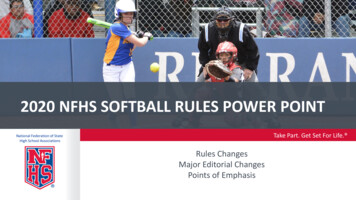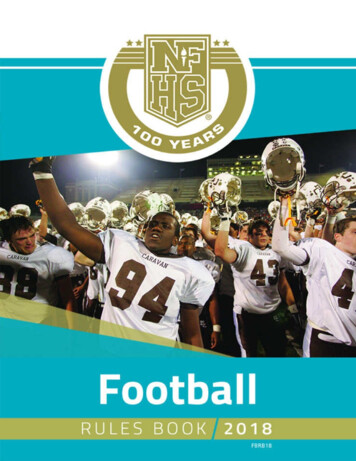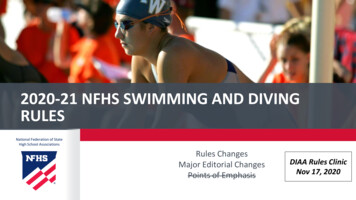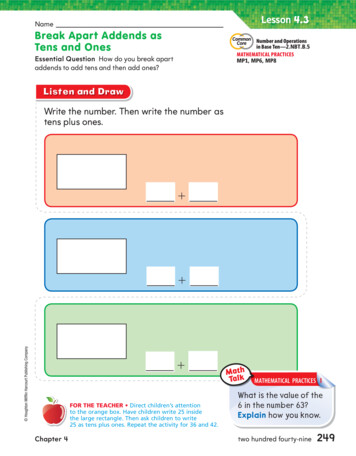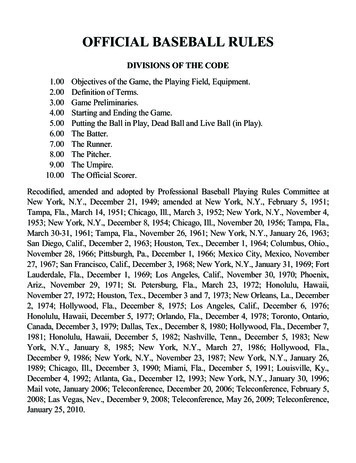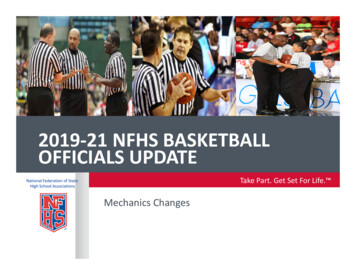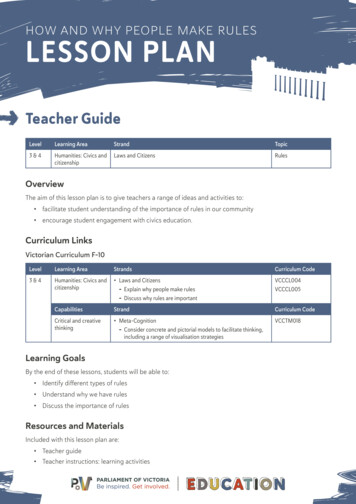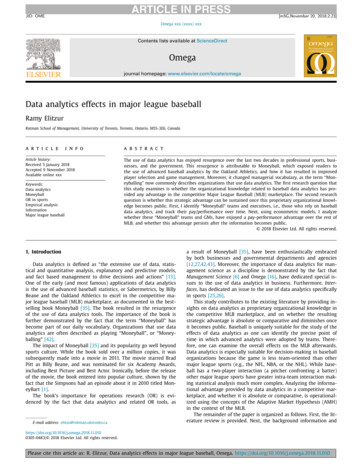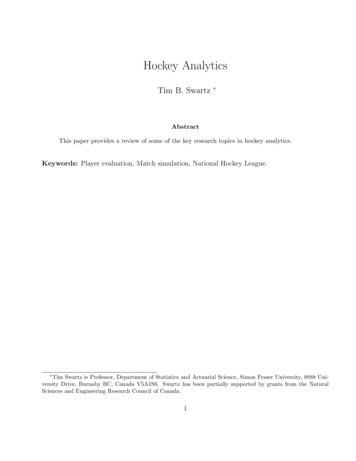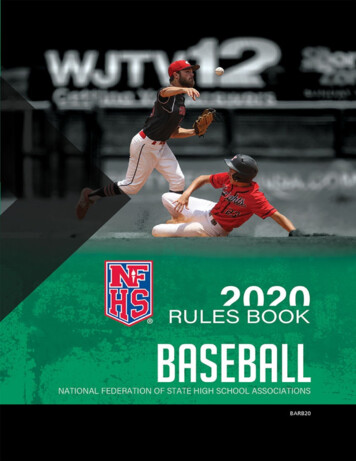
Transcription
2020 NFHS BASEBALL RULESBOOKDr. KARISSA L. NIEHOFF, PublisherB. Elliot Hopkins, MLD, CAA, EditorNFHS PublicationsTo maintain the sound traditions of this sport, encourage sportsmanship andminimize the inherent risk of injury, the National Federation of State HighSchool Associations writes playing rules for varsity competition amongstudent-athletes of high school age. High school coaches, officials andadministrators who have knowledge and experience regarding this particularsport and age group volunteer their time to serve on the rules committee.Member associations of the NFHS independently make decisions regardingcompliance with or modification of these playing rules for the studentathletes in their respective states.NFHS rules are used by education-based and non-education-basedorganizations serving children of varying skill levels who are of high schoolage and younger. In order to make NFHS rules skill-level and age-levelappropriate, the rules may be modified by any organization that chooses touse them. Except as may be specifically noted in this rules book, the NFHSmakes no recommendation about the nature or extent of the modificationsthat may be appropriate for children who are younger or less skilled thanhigh school varsity athletes.Every individual using these rules is responsible for prudent judgment withrespect to each contest, athlete and facility, and each athlete is responsiblefor exercising caution and good sportsmanship. These rules should beinterpreted and applied so as to make reasonable accommodations forathletes, coaches and officials with disabilities. 2019, By the National Federation of State High School Associations.
Neither the whole nor any part of this publication may be copied orreproduced and/or translated without first obtaining express writtenpermission from the publisher.Republication of all or any portion of this publication on the Internet isexpressly prohibited. Published by the NATIONAL FEDERATION OFSTATE HIGH SCHOOL ASSOCIATIONS, PO Box 690, Indianapolis,Indiana 46206; Phone: 317-972-6900, Fax: 317.822.5700, www.nfhs.org.Cover photo courtesy of Keith Warren, Mississippi High SchoolActivities Association.
TABLE OF CONTENTSRule 1. Players, Field and EquipmentRule 2. Playing Terms and DefinitionsRule 3. Substituting – Coaching – Bench and Field Conduct – ChargedConferencesRule 4. Starting and Ending GameRule 5. Dead Ball – Suspension of PlayDead Ball TablesRule 6. PitchingRule 7. BattingRule 8. BaserunningBaserunning Awards TableRule 9. Scoring – Record KeepingRule 10. UmpiringSuggested Speed – Up RulesSuggested Double First Base RulesPoints of EmphasisComments on the RulesRules by State Association AdoptionOfficials’ Signal Chart
Mission StatementSuggested Guidelines for Management of Concussion in SportsEquipment GuidelinesCommunicable Disease ProceduresLightning GuidelinesCoaches Code of EthicsOfficials Code of Ethics
NFHS DisclaimersEach state high school association adopting these rules is the sole andexclusive source of binding rules interpretations for contests involving itsmember schools. Any person having questions about the interpretation ofNFHS rules should contact the rules interpreter designated by his or her statehigh school association.The NFHS is the sole and exclusive source of model interpretations of NFHSrules. State rules interpreters may contact the NFHS for model rulesinterpretations. No other model rules interpretations should be considered.DISCLAIMER – NFHS Position Statements and GuidelinesThe NFHS regularly distributes position statements and guidelines topromote public awareness of certain health and safety-related issues. Suchinformation is neither exhaustive nor necessarily applicable to allcircumstances or individuals, and is no substitute for consultation withappropriate health-care professionals. Statutes, codes or environmentalconditions may be relevant. NFHS position statements or guidelines shouldbe considered in conjunction with other pertinent materials when takingaction or planning care. The NFHS reserves the right to rescind or modifyany such document at any time. Position Statements are located at the end ofthis eBook.Requests for baseball rule interpretations or explanations should be directedto the state association responsible for the high school baseball program inyour state. The NFHS will assist in answering rules questions from stateassociations whenever called upon.FACILITIESBecause facilities used for high school athletics come in many shapes, sizesand conditions, on-site event management may on occasion conclude thatcompliance with NFHS directives about event configuration is not feasible.Under all circumstances, onsite event management should utilize set-ups thatminimize risk under the conditions with which they deal. If a given facilitycannot be made reasonably hazard-free, the event should be relocated.
New rules changes are denoted with highlights.
2020 Baseball Rules Changes(For comments on the 2020 rules changes, see Rules Changes Comments)3-1-4 — Modified the role of the defensive player and the designated hitter.
2020 Baseball Points of Emphasis(For a complete discussion of these points of emphasis, see Points ofEmphasis Discussion)1. Game-Ending Procedures2. Player/Designated Hitter Role3. Proper Pitching Positions4. Force Play Slide Rule5. Enforcement of NFHS Jewelry Rule6. Compliance of Player’s Equipment
NFHS Baseball Rules Committee
Rule 1 Players, Field and EquipmentThe NFHS does not perform scientific tests on any specific items ofequipment to determine if the equipment poses undue risks to studentathletes, coaches, officials or spectators. Such determinations are theresponsibility of equipment manufacturers.
SECTION 1 POSITIONS OF PLAYERSART. 1 . . . In high school baseball, each team is permitted seven turns at bat(see 4-2-2) during which it attempts to score runs by having its battersbecome base runners who advance to and touch first base, second base, thirdbase and home plate. The team in the field attempts to end each turn at bat ofthe opponent by causing three of its batters or base runners to be out. Each ofthe two teams consists of at least nine players throughout the game (SeeException 4-4-1f), one of whom must be designated captain.ART. 2 . . . The captain and head coach represent the team incommunications with umpires. The captain's and head coach’s duties shallinclude: 1) providing the umpire-in-chief with his team's lineup card whichshall include the name, shirt number, position and batting order of eachstarting player, the name and shirt number of each eligible substitute shouldalso be listed; and 2) informing all players as to special ground rules asannounced by the umpire-in-chief. Lineups become official after they havebeen exchanged, verified and then accepted by the umpire during thepregame conference. The umpire shall not accept the lineup card until allsubstitutes are listed. There is no penalty assessed.Diagram 1:Key: 1—Pitcher; 2—Catcher; 3—1st Baseman; 4—2nd Baseman; 5—3rd
Baseman; 6—Shortstop; 7—Left Fielder; 8— Center Fielder; 9—RightFielder; U—Umpire; X—On-Deck Circle; Stippled Area—GrassART. 3 . . . A player is designated on the line up card and in the scorebookby name, shirt number, batting order position and fielding position. Acustomary arrangement of the fielders is shown in Diagram 1.ART. 4 . . . At the time of the pitch, all fielders shall be on fair groundexcept the catcher who shall be in the catcher's box. A fielder is in fairground when at least one foot is touching fair ground.PENALTY: Illegal pitch. (2-18)ART. 5 . . . A player may change to a different fielding position at any timeexcept that a pitcher, after being listed as such on the official lineup cardhanded the umpire, cannot change until conditions in 3-1-1 and 2 are met.Changes should be reported to the umpire-in-chief and scorekeeper.
SECTION 2 THE FIELDART. 1 . . . A diamond (or infield) shall be a 90-foot square. Whenmeasuring the distance to first base and third base, measure from the apex ofhome plate to the back edge of the base. The outfield is the area between twofoul lines formed by extending two sides of the diamond as in Diagram 2.The infield and outfield, including the boundary marks from home plate tofirst and third and their extended foul lines, are fair ground. All other area isfoul ground.ART. 2 . . . All lines on the playing field shall be marked with a materialwhich is not injurious to the eyes or skin. All non-permanent lines should bewhite. Lime or caustic material of any kind is prohibited.ART. 3 . . . The on-deck circle should be to the side and away from homeplate, 37 feet if space allows. Neither team's players shall warm up in theother team's on-deck circle. The on-deck circle does not have to be occupied,but if a player wishes to warm up, he shall do so only in his team's on-deckcircle, provided the on-deck circle is located safely away from home plate.(2-23)ART. 4 . . . When the dugout area is temporarily extended, for any reason, itshall be extended toward the outfield on a line parallel to the foul line. Theextension of the dugout area shall be equally applied for both teams.ART. 5 . . . When constructing a new field for high school play, the distancefrom home plate to the nearest obstruction on fair ground should be at least300 feet down the foul lines and at least 350 feet to center field. It isrecommended that the line from home plate through the pitcher's plate tosecond base run east-northeast. This line, using a steel tape or a strong tapeor a cord, must measure 127 feet, 3 3/8 inches from the rear tip of home plateto the middle of second base. The catcher's box, home plate, bases, coaches'boxes, batters' boxes, and three-foot running lane shall be as in Diagram 2.The recommended width of a foul line is 2 ½ inches.ART. 6 . . . On a sodded field, an unsodded area, commonly referred to asthe "pitcher's mound," should have a radius of about nine feet centered 1½feet in front of the midpoint of the front edge of the pitcher's plate.
Diagram 2OFFICIAL MEASUREMENTS . . . for laying out baseball fieldDiagram 3
SUGGESTED LAYOUT OF PITCHER'S MOUNDThe top of the pitcher's plate must be 10 inches above the top surface ofhome plate. Inside the circle, a pitcher's mound should be constructedaccording to the specifications shown in the diagram.The degree of slope from a point 6 inches in front of the pitcher's plate to apoint 6 feet toward home plate shall be one inch to one foot, and such degreeof slope shall be uniform.The pitching mound is an 18-foot diameter circle, the center of which is 59feet from the back point of home plate.Locate the front edge of the rubber 18 inches behind the center of the mound.The front edge of the rubber to the back point of home plate is 60 feet, 6inches.The slope starts 6 inches from the front edge of the rubber.The slope shall be 6 inches from the starting point, 6 inches in front of therubber to a point 6 feet in front of the rubber.
The level area surrounding the rubber should be 6 inches in front of therubber, 18 inches to each side and 22 inches to the rear of the rubber. Thetotal level area is 5 feet x 34 inches.ART. 7 . . . The pitcher's mound may consist in part of synthetic materialthat is commercially manufactured for that purpose. If a mound pad iscomposed of natural soil and synthetic material, the synthetic material mustbe securely attached to the ground and be installed at least flush or slightlybelow the surface of the ground. The mound area shall meet suggested heightand slope specifications found in the Suggested Layout of the Pitcher'sMound (Diagram 3).ART. 8 . . . Media shall be prohibited from being in live-ball area. If adesignated media area is to be used, it shall be established before the gamebegins. The home team or game management shall designate a lined area forthe media, which shall be considered dead-ball area.ART. 9 . . . First, second and third bases shall be white bags, 15 inchessquare and 2 to 5 inches in thickness, and made of canvas filled with a softmaterial, or molded rubber or synthetic material, and shall be securelyattached to the ground or an anchor system as in Diagram 2. Bases may havetapered edges and/or be designed to disengage from their anchor systems. Bystate association adoption, a double first base is permitted. The double firstbase shall be a white base and a colored base. The colored base shall belocated in foul territory. (See Suggested Double First Base Rules)ART. 10 . . . Home plate shall be a five-sided slab of whitened rubber orother suitable similar material. One edge is 17 inches long, two are 8 ½inches and two are 12 inches. It shall be set in the ground so that the two 12inch edges coincide with the diamond lines extending from home plate tofirst base and to third base, with the 17-inch edge facing the pitcher's plate.ART. 11 . . . The pitcher's plate shall be a rectangular slab of whitenedrubber or suitable material, 24 inches by 6 inches. It shall be set in theground as shown in Diagram 2 so that the distance between the nearer edgeof the pitcher's plate and the rear tip of home plate shall be 60 feet, 6 inches.ART. 12 . . . Any game started on a nonregulation facility by mutualagreement of the opposing coaches shall not be protested for this reason.
SECTION 3 BATS, BALLS AND GLOVESART. 1 . . . The ball shall meet the current NOCSAE standard for baseballsat the time of manufacture and is required on balls that will be used in highschool competition (Effective January 1, 2020). The SEI/NOCSAE mark isrequired on all balls that meet the NOCSAE standard that will be used inhigh school competition. Please see the mark below. A minimum of threeumpire-approved baseballs shall be provided to start the game. Unlessotherwise mutually agreed upon, the home team has this responsibility. Noless than two baseballs shall be used to complete a game.The NFHS Authenticating Mark is required on all balls that will be used inhigh school competition.A current list of NFHS authenticated products can be found on the website:www.nfhs.org.ART. 2 . . . The bat shall have the following characteristics and components.a. Each legal wood, aluminum or composite bat shall:1. Be one piece, multi-pieces and permanently assembled, or two
pieces with interchangeable barrel construction.2. Not have exposed attachments, rivets, pins, rough or sharp edgesor any form of exterior fastener that would present a potentialhazard.3. Be free of rattles, dents, burrs, cracks and sharp edges. Bats thatare broken, altered or that deface the ball are illegal. Materialsinside the bat or treatments/devices used to alter the batspecifications and/or enhance performance are prohibited andrender the bat illegal.b. Each legal wood, aluminum or composite bat shall have thefollowing components:1. Knob – The bat knob shall protrude from the handle. The knobmay be molded, lathed, welded or permanently fastened.Wrappings are permitted except those that cause the knob tobecome flush with the handle. A one-piece rubber knob and batgrip combination is illegal.2. Handle – The bat handle is the area of the bat that begins at, butdoes not include, the knob and ends where the taper begins.3. Barrel – The barrel is the area intended for contact with apitched ball. The barrel shall be round, cylindrically symmetric,with a smooth contour. The barrel may be aluminum, wood orcomposite (made of two or more materials). The type of bat (wood,aluminum or composite) shall be determined by the composition ofthe barrel.4. Taper – The taper is an optional transition area which connectsthe narrower handle to the wider barrel portion of the bat. Itslength and material may vary but may not extend more than 18inches from the base of the knob.5. End Cap – The end cap is made of rubber, vinyl, plastic or otherapproved material. It shall be firmly secured and permanentlyaffixed to the end of the bat so that it cannot be removed by anyoneother than the manufacturer, without damaging or destroying it. By
definition, a one-piece construction bat does not have an end cap.c. Each bat not made of a single piece of wood shall:1. Have a safety grip made of cork, tape (no smooth, plastic tape)or commercially manufactured composition material. The gripmust extend a minimum of 10 inches, but not more than 18 inches,from the base of the knob. Slippery tape or similar material shallbe prohibited. Resin, pine tar or any drying agent to enhance thehold are permitted only on the grip. Molded grips are illegal.2. Be 2 5/8” or less in diameter at thickest part and 36 inches orless in length.3. Not weigh, numerically, more than three ounces less than thelength of the bat (e.g., a 33-inch-long bat cannot be less than 30ounces).d. Bats that are not made of a single piece of wood shall meet the BattedBall Coefficient of Restitution (BBCOR) performance standard, andsuch bats shall be labeled with a silkscreen or other permanentcertification mark. No BBCOR label, sticker or decal will be acceptedon any non-wood bat. The certification mark shall be rectangular, aminimum of one inch on each side and located on the barrel of the batin any contrasting color to read: “BBCOR .50.”NOTE: The NFHS has been advised that certain manufacturers consideralteration, modification and "doctoring" of their bats to be unlawful andsubject to civil and, under certain circumstances, criminal action.ART. 3 . . . A bat made of a single piece of wood may be roughened orwound with tape not more than 18 inches from the handle end of the bat. Noforeign substance may be added to the surface of the bat beyond 18 inchesfrom the end of the handle. Each bat made of a single piece of wood shall be:a. 2¾ inches or less in diameter at the thickest partb. 36 inches or less in lengthART. 4 . . . Only bats may be used in warming up (including weighted bats
used for this purpose) at any location. Only bats and items designed toremain part of the bat, such as weighted bats, batting donuts, and windresistant devices are legal at any location.ART. 5 . . . Bats that are altered from the manufacturer’s original design andproduction, or that do not meet the rule specifications, are illegal (See 7-41a). No artificial or intentional means shall be used to control thetemperature of the bat. No foreign substance may be inserted into the bat.Bats that are broken, cracked or dented or that deface the ball, i.e., tear theball, shall be removed without penalty. A bat that continually discolors theball may be removed from the game with no penalty at the discretion of theumpire.ART. 6 . . . Gloves/mitts made of leather shall be worn by all fielders andnot be altered to create an adhesive, sticky, and/or tacky surface. Theglove/mitt worn by the catcher may be any size. The glove/mitt worn by thepitcher that includes the colors white and/or gray shall be removed from thegame upon discovery by either team and/or umpire. The glove/mitt worn byall fielders except the catcher shall conform to the following maximumspecifications (found in Diagram 4):a. Height (measured from the bottom edge or heel straight up across thecenter of the palm to a line even with the highest point of theglove/mitt): 14 inchesb. Width of palm (measured from the bottom edge of the webbingfarthest from the thumb in a horizontal line to the outside of the littlefinger edge of the glove/mitt): 8 inchesc. Webbing (measured across the top end or along any line parallel tothe top): 5 ¾ inchesDiagram 4
ART. 7 . . . Loose equipment, such as gloves, bats, helmets or catcher's gear,of either team may not be on or near the field.PENALTY: If loose equipment interferes with play, the umpire may callan out(s), award bases or return runners, based on his judgment and thecircumstances concerning the play.
SECTION 4 UNIFORMSART. 1 . . . Uniforms of all team members should be of the same color andstyle. Caps and shoes are required equipment (no track spikes allowed).When a player is required to wear a head protector, it replaces the cap asmandatory equipment.ART. 2 . . . For individual players, uniform sleeve lengths may vary.However, sleeves of each individual player shall be approximately the samelength and shall not be ragged, frayed or slit. If the pitcher’s undershirtsleeves are exposed, they shall not be white or gray. Compression sleevesthat are solid black or solid dark-colored shall be the only colors allowed tobe worn by the pitcher below his elbow. A pitcher shall not wear any item onhis hands, wrists or arms which may be distracting to the batter. A pitchershall not wear white or gray exposed undershirt sleeves or any white or graysleeve that extends below the elbow. A vest and coordinating shirt that isworn underneath is viewed as a type of uniform top.ART. 3 . . . A uniform shall not have any dangerous or reflective buttons orornaments. Each player shall be numbered on the back of his shirt with aplain number of solid color contrasting with the color of the shirt. Thisnumber shall be a plain Arabic style and shall be at least eight inches high,and no players on the same team shall wear identical numbers. A numbermay have a border of not more than one-quarter inch in width.ART. 4 . . . The school's official uniform (including uniform pants, jersey,visible undergarments, socks, stockings, caps and headwear) may bear only avisible single manufacturer's logo (partial or whole) or trademark. Amanufacturer's logo/trademark shall not exceed 2 ¼ square inches with nodimension exceeding 2 ¼ inches. No more than one manufacturer’slogo/trademark or reference shall be permitted on the outside of each item.(The same restriction shall apply to either the manufacturer’s logo/trademarkor reference.) One American flag 2 inches x 3 inches may be worn or occupyspace on each item of uniform apparel.By state association adoption, to allow for special occasions,commemorative or memorial patches, that will be uniformly placed, not toexceed 4 square inches, to be worn on jerseys in an appropriate and dignified
manner without compromising the integrity of the uniform.
SECTION 5 PLAYER EQUIPMENTART. 1 . . . It is mandatory for on-deck batters, batters, runners, retiredrunners, players/students in the coaches boxes as well as non-adult bat/ballshaggers to wear a batting helmet that has a non-glare (not mirror-like)surface and meets the NOCSAE standard at the time of manufacture. Thebatting helmet shall have extended ear flaps that cover both ears and templesand also display the NOCSAE stamp and the exterior warning statement. Thewarning statement may be affixed to the helmet in sticker form, or it may beembossed at the time of manufacture. A violation by a non-adult bat/ballshagger shall result in a warning to the coach of the team and the individual.A subsequent violation may result in the individual not being allowed on thefield.PENALTY: When an umpire observes anyone who is required to wear abatting helmet deliberately remove his batting helmet while in live-ballterritory and the ball is live (non-adult ball/bat shaggers required towear batting helmet in live-ball area even if ball is dead), the umpireshall issue a warning to the coach of the involved team, unless the ballbecomes dead without being touched by a fielder or, after being touched,goes directly to dead-ball area. A subsequent violation of the rule shallresult in ejection.ART. 2 . . . A face mask/guard may be attached to batting helmets at thetime of manufacture. All face mask/guards shall meet the NOCSAE standardat the time of manufacture. A face mask/guard specifically designed for aparticular helmet model may be attached after manufacture, provided thatprocedure is approved by the manufacturer and meets the NOCSAE standardat the time of manufacture.ART. 3 . . . The catcher shall wear, in addition to a head protector, a maskwith a throat protector, body/chest protector that meets the NOCSAEstandard at the time of manufacture (Effective January 1, 2020), protectivecup (male only), and baseball protective shin guards. The SEI/ NOCSAEmark is required on all body/chest protectors that meets the NOCSAEstandard at the time of manufacture that will be used in high schoolcompetition. Please see the accompanying mark.
ART. 4 . . . The catcher's helmet and mask combination shall meet theNOCSAE standard at the time of manufacture. Any helmet or helmet andmask combination shall have full ear protection (dual ear flaps). A throatprotector, which is either a part of or attached to the catcher's mask, ismandatory. A throat protector shall adequately cover the throat. Thecommercially manufactured catcher's head, face and throat protection may bea one-piece or multi-piece design. While in a crouch position, any nonadultwarming up a pitcher at any location shall wear a head protector, a maskwith a throat protector and a protective cup (male only).PENALTY: Failure by a player to wear proper equipment after being soordered by the umpire, shall result in ejection.ART. 5 . . . Defensive players are permitted to wear face/head protection inthe field. If a pitcher or any defensive player wears face/head protection, itsouter covering shall have a non-glare (not mirror-like) surface.ART. 6 . . . Defective equipment must be repaired or replaced immediately.ART. 7 . . . If a ball is touched with an illegal glove or mitt, that isdiscovered by the umpire, the coach or captain of the team at bat has thechoice of taking the result of the play or having the award (8-3-3a, b, c) for
use of an illegal glove or mitt. The illegal glove or mitt must be replacedimmediately. A foul fly caught with an illegal glove/mitt shall be nullifiedand treated as a foul ball, unless the team at bat elects to take the result of theplay.ART. 8 . . . Hard and unyielding items (guards, casts, braces, splints, etc.)must be padded with a closed-cell, slow-recovery foam padding no less than1/2" thick. Knee and ankle braces which are unaltered from themanufacturer's original design/production do not require any additionalpadding. Each state association may, in keeping with applicable laws,authorize exceptions to NFHS playing rules to provide reasonableaccommodations to individual participants with disabilities and/or specialneeds, as well as those individuals with unique and extenuatingcircumstances. The accommodations should not fundamentally alter thesport, allow an otherwise illegal piece of equipment, create risk to theathlete/others or place opponents at a disadvantage.ART. 9 . . . Any player equipment judged by the umpire to be unreasonablydangerous is illegal.ART. 10 . . . Any questions regarding legality of a player's equipment shallbe resolved by the umpire-in-chief.ART. 11 . . . Non-traditional playing equipment must be reviewed by theNFHS Baseball Rules Committee before it will be permitted to be used.ART. 12 . . . Jewelry shall not be worn (See 3-3-1d) except for religious ormedical medals. A religious medal must be taped and worn under theuniform. A medical alert must be taped and may be visible.
Rule 2 Playing Terms and Definitions
SECTION 1 ABBREVIATIONSART. 1 . . . For brevity in the play rulings, the home team is H and thevisiting team V.ART. 2 . . . Players of the team at bat are B1, B2, etc. The player who batsfirst in his half of an inning is designated B1. The second player to bat is B2,etc. Substitutes are S1, S2, etc. Runners are R1, R2, or R3. R1 occupies firstbase, R2 occupies second base, and R3 occupies third base.ART. 3 . . . Fielding players are F1, F2, etc., in accordance with Diagram 1.
SECTION 2 AWARDED BASESWhen bases are awarded, it is the responsibility of the runner to legally touchthose bases. In actuality, it is the right to advance without a play being madethat is awarded.
SECTION 3 BALKA balk is an illegal act committed by the pitcher with a runner(s) on basewhich entitles each runner to advance one base.
SECTION 4 BALL, BASE ON BALLS, INTENTIONALBASE ON BALLSART. 1 . . . The ball is one of the playing implements (See 1-3-1). The termis also used to designate a pitch which is not touched by the bat and is not astrike as in 7-2-1 and 7-2-2.ART. 2 . . . A base on balls is an award of first base (often referred to as a“walk”) if a batter receives four such balls. The batter must go immediatelyto first base before time-out is called.ART. 3 . . . An intentional base on balls may be given by the defensive teamby having its catcher or coach request the umpire to award the batter firstbase. This may be done before pitching to the batter or on any ball and strikecount. The ball shall be declared dead before making the award.
SECTION 5 FAIR BALL/BASE HITART. 1 . . . A fair ball is a batted ball which:a. settles on fair territory between home and third base or between homeand first base; orb. contacts fair ground on or beyond an imaginary line between first andthird base; orc. is on or over fair ground when bounding to the outfield past first orthird base; ord. first falls on fair ground on or beyond first or third base; ore. touches first, second or third base; orf. while on or over fair territory, touches the person of an umpire orplayer, their clothing or equipment; org. while over fair ground passes out of the playing field in flight.1. A fly ball or line drive, which passes over or inside first or thirdbase in flight and curves to foul ground beyond such base, is not afair hit; but a hit which goes over or through the fence is a fair hitif it is over fair ground when it leaves the field.ART. 2 . . . A base hit (also called a safe hit or single) is one which enablesthe batter to advance to first base without being put out (9-3-2).ART. 3 . . . An extra base hit is one which enables the batter to advance tofirst base and then to one or more succeeding bases (9-3-3). A two-base hit(double), three-base hit (triple) or home run enables him to reac
Except as may be specifically noted in this rules book, the NFHS . cannot be made reasonably hazard-free, the event should be relocated. New rules changes are denoted with highlights. . be securely attached
